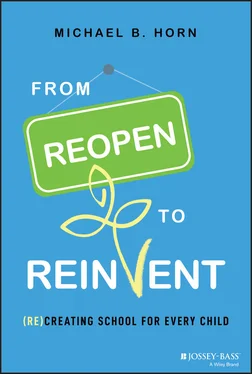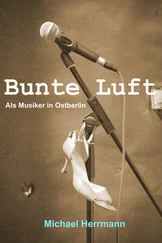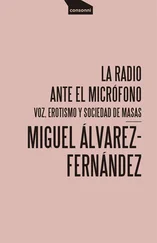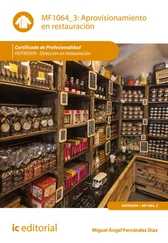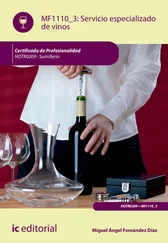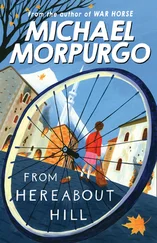Michael B. Horn - From Reopen to Reinvent
Здесь есть возможность читать онлайн «Michael B. Horn - From Reopen to Reinvent» — ознакомительный отрывок электронной книги совершенно бесплатно, а после прочтения отрывка купить полную версию. В некоторых случаях можно слушать аудио, скачать через торрент в формате fb2 и присутствует краткое содержание. Жанр: unrecognised, на английском языке. Описание произведения, (предисловие) а так же отзывы посетителей доступны на портале библиотеки ЛибКат.
- Название:From Reopen to Reinvent
- Автор:
- Жанр:
- Год:неизвестен
- ISBN:нет данных
- Рейтинг книги:4 / 5. Голосов: 1
-
Избранное:Добавить в избранное
- Отзывы:
-
Ваша оценка:
- 80
- 1
- 2
- 3
- 4
- 5
From Reopen to Reinvent: краткое содержание, описание и аннотация
Предлагаем к чтению аннотацию, описание, краткое содержание или предисловие (зависит от того, что написал сам автор книги «From Reopen to Reinvent»). Если вы не нашли необходимую информацию о книге — напишите в комментариях, мы постараемся отыскать её.
From Reopen to Reinvent,
From Reopen to Reinvent
From Reopen to Reinvent
From Reopen to Reinvent — читать онлайн ознакомительный отрывок
Ниже представлен текст книги, разбитый по страницам. Система сохранения места последней прочитанной страницы, позволяет с удобством читать онлайн бесплатно книгу «From Reopen to Reinvent», без необходимости каждый раз заново искать на чём Вы остановились. Поставьте закладку, и сможете в любой момент перейти на страницу, на которой закончили чтение.
Интервал:
Закладка:
About the Author
Michael B. Hornstrives to create a world in which all individuals can build their passions and fulfill their potential through his writing, speaking, and work with a portfolio of education organizations. He is the author of many books, including the award-winning Disrupting Class: How Disruptive Innovation Will Change the Way the World Learns ; Blended: Using Disruptive Innovation to Improve Schools ; Choosing College: How to Make Better Learning Decisions Throughout Your Life ; and Goodnight Box , a children's story.
Michael is the cofounder of and a distinguished fellow at the Clayton Christensen Institute, a nonprofit think tank. He cohosts the popular education podcasts Class Disrupted and Future U . He also serves as an executive editor at Education Next .
Michael was selected as a 2014 Eisenhower Fellow to study innovation in education in Vietnam and Korea, and Tech & Learning magazine named him to its list of the 100 most important people in the creation and advancement of the use of technology in education. He holds a BA in history from Yale University and an MBA from the Harvard Business School.
Foreword
Fine. The word I most often hear people use to describe how their child is doing in school is “fine.” And these are the people whose children are doing best in school. I believe our children, our communities, and our country need better than fine. I think most people agree. The challenge is, how do we transform schools that are “fine” for some to places that are preparing all for a good life?
I met Michael sometime around 2011, when we discovered in a public dialogue that we share a vision for what American schools can be and a disappointment in what they are. As it turned out, we also share a commitment to doing everything in our power to help schools realize a much more compelling vision.
In late March of 2020, a few weeks after working around the clock to convert all of our schools from in-person to virtual in response to the global pandemic, I had two realizations. First, closing our school buildings was the easy part. Getting back into the buildings was going to be a long and difficult process, and there would be real costs for the students. And second, given that toll, we could not waste this unprecedented opportunity to truly redesign schools to serve every student and society, which even our “best” schools simply aren't doing. The next thing I did was call Michael.
My pitch was simple. The pandemic might be a once-in-a-lifetime opportunity to transform schools (he agreed). Parents are seeing first-hand some of the significantly flawed structures and elements of schools that need changing (he really agreed as a parent). Redesigning during a crisis would be extraordinarily challenging and we should try to make it as easy as possible (he was in). As a first step, we decided to create the podcast Class Disrupted to surface real questions from families stemming from the pandemic chaos, ask “experts” to illuminate design principles and design advice, and then engage in real talk about what is required for schools to change.
Michael then took this joint project a step further. In this book he captures the best of those discussions and our dialogue over the past two years and combines them with additional research and insights. He has the incredible ability to take nuanced ideas and make them clear and, most importantly, implementable. His curiosity leads him to pursue understanding to a depth that is imperative for those of us who are doing the work. Over a decade ago, the book he coauthored with Clay Christensen, Disrupting Class , played a profound role in how we at Summit thought about redesigning our school model.
Leading and operating schools during these pandemic years is by far the most demanding and least rewarding experience I've had in my 25 years as an educator. On many days, simply keeping schools open takes every minute and all of the energy. Finding the mental space to step back and up to seize this moment, which is begging us to change, most often feels untenable, and yet imperative. It is my hope that this new book is as faithful and helpful a companion to educators, parents, and policymakers alike as Michael's previous works and weekly conversations have been for me.
Diane Tavenner
Cofounder and CEO of Summit Public Schools
Cohost of the podcast Class Disrupted
Author of Prepared: What Kids Need for a Fulfilled Life
The Story of Jeremy and Julia
Jeremy and Julia are two of the 600 students at Spruce Park Elementary School in California .
As the bus rolled in to the school parking lot at 8:30 a.m., Jeremy trudged down the stairs and outside. He yawned .
After pausing for a moment, he noticed his fellow fifth-grade classmate Julia and a couple of her friends skipping up the hill to school. Walkers, he thought. A moment of envy flashed through his mind and then passed. He waved to Julia, who smiled and waved back .
Then his stomach grumbled. He turned to walk toward the school cafeteria to grab a quick bite before the bell rang. His mom had been so tired from working the late shift at the convenience store that she hadn't had time to scrounge some breakfast together. Again .
Jeremy couldn't sort through what was worse: when his mom was laid off when the pandemic started and she moped around the house all day while he was stuck inside away from his friends, school, and reliable food, or now when she had finally decided to work again and barely saw him—but at least he could see his friends at school and eat the cafeteria food. Maybe his teacher, Mrs. Alvarez, would ask him to write about it again. He sighed .
While Jeremy scarfed down food in the cafeteria, Julia happily skipped rope with her friends as they waited for the bell to ring. She loved these precious moments with her friends before they were told to sit silently during class and before the cascade of after-school activities that greeted her each day after dismissal. She loved gymnastics, piano, soccer, and robotics, but she sometimes longed for parts of the early days of the pandemic when the whole neighborhood was outside playing games of socially distant hopscotch under the California sun .
The principal, Dr. Kathleen Ball, watched all the students arrive—bussers and walkers alike. Her gaze was pleasant as she greeted each child by name. But her mind was elsewhere, as she wondered what was worse—the chaos and confusion of the early days of the pandemic or the tormented and unsettled nature of the current school year with so many students having so many different needs and so many parents frustrated that their child's needs still weren't being met .
Things were hard at the outset of COVID—so many decisions to make, so much uncertainty, so little time .
Ball had been so proud of how her teachers banded together and came up with creative solutions. They weren't perfect. But what they put together and the speed with which they did so was better than the alternative .
The parents were so kind, understanding, and appreciative back then. They understood the stress under which she and all her teachers were operating—even as they dealt with so much at home as well .
Things were different now. Different pockets of parents had different priorities and opinions. On everything .
That had always been true, of course. But now there was less trust. Needs had gone unmet and become more severe. Parents held higher expectations that these needs would be—no, should be—met. Many displayed a lack of common courtesy .
Читать дальшеИнтервал:
Закладка:
Похожие книги на «From Reopen to Reinvent»
Представляем Вашему вниманию похожие книги на «From Reopen to Reinvent» списком для выбора. Мы отобрали схожую по названию и смыслу литературу в надежде предоставить читателям больше вариантов отыскать новые, интересные, ещё непрочитанные произведения.
Обсуждение, отзывы о книге «From Reopen to Reinvent» и просто собственные мнения читателей. Оставьте ваши комментарии, напишите, что Вы думаете о произведении, его смысле или главных героях. Укажите что конкретно понравилось, а что нет, и почему Вы так считаете.
